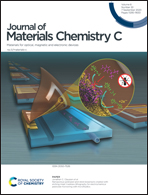Ultralong organic luminogens with color-tunability via intermolecular through-space charge-transfer characters†
Abstract
Currently, the majority of ultralong organic luminescence (UOL) materials show an undiversified color of yellow with a vibrational-structured spectrum [λUOL: ∼550 nm; shoulders: ∼600 and ∼650 nm]. Herein, we demonstrate that the radiative deactivation of singlet and/or triplet excitons showing an intermolecular through-space charge-transfer (I-TSCT) character can also result in UOL. With the aid of their CT feature of the long-lived excited state, the emission color of UOL materials based on this mechanism can be fine-tuned rationally. Using this constructive strategy, compounds CzSO and β-CbSO with λUOL of 490 nm and 460 nm, respectively, have been acquired successfully. Note that the UOL of CzSO has a long lifetime of 0.45 s together with a quantum efficiency over 26% under visible-light excitation at 440 nm. Moreover, thanks to its ground-state CT character, bright two-photon excited UOL is also observed in crystalline CzSO under near-infrared (NIR) excitation at 840 nm.



 Please wait while we load your content...
Please wait while we load your content...